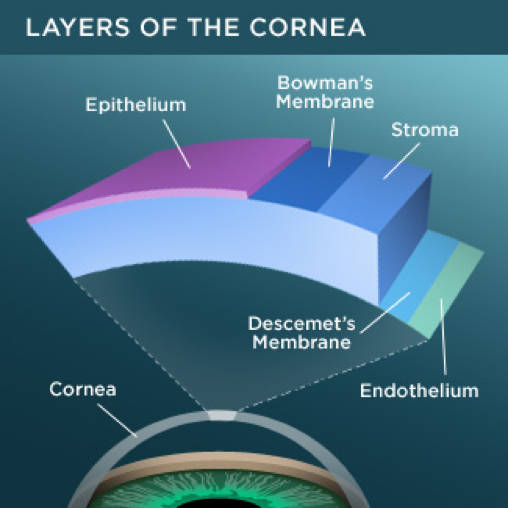“Put some Windex on it!”. That was the hilarious advice given by the bride’s father for any and every malady in the classic movie, ‘My Big Fat Greek Wedding’. Interestingly, though Windex works great on windows, it doesn’t do a very good job on the windows of the eyes.
The cornea is the window of your eye. It is the transparent, dome-shaped covering over the eye through which you see the world. This beautiful piece of anatomy is a complex structure made of different layers, as you may imagine. The cornea is as robust as it is delicate.
Clearly unnoticed, you could be forgiven for forgetting about yours until you get some Windex in it!
One of the most important and active layers of the cornea is the innermost lining called the endothelium (the green layer in the image below). If you think about it, the cornea is bathed by fluid on the inside and outside of your eye – so how does it stay transparent?? This is where the endothelium takes stage.
The endothelial cell layer is indeed a pump that works 24/7 to keep fluid out of your cornea and thereby transparent. As we all know, things can and do go wrong with our bodies and the corneal endothelium and its neighboring membrane, Descemet’s membrane, is no exception. Some of the most common diseases that can affect and compromise the endothelium are Fuchs’ Dystrophy and Pseudophakic Bullous Keratopathy. In both these diseases, the endothelium ceases to function and peak capacity and over time can allow fluid to enter the cornea rendering it cloudy. I often describe this as a clear window becoming frosted. What happens to images through a frosted window?
Just over a decade ago, should you have diseases limited to the endothelium, you were forced to have the entire window, or cornea, replaced. Thanks to the pioneering work of brilliant minds in the past, today’s Cornea Specialist eye surgeons are now able to replace just the inner layer. Though different terminology has evolved over time, the term DSEK remains popular. DSEK: Descemet Stripping Endothelial Keratoplasty is a highly evolved procedure where just ~ 70-90 microns of donor corneal tissue is transplanted into the patient’s eye.
The benefits of replacing just one layer are many including shorter post op recovery, faster visual recovery, less chance of rejection and less invasive repeatability. Surgery is typically insurance covered and takes less than an hour and can often be combined with cataract surgery when necessary. As an outpatient procedure in our surgery center, patients return home within hours and are asked to follow some specific instructions to maximize the chances of success. Visual recovery typically takes a few days, after which, vision improves gradually for several weeks more. Typically, patients can regain excellent levels of vision. Surgeons monitor patients on day one, week one and then monthly for a few months during which patients use a tapering dose of steroid eye drops to prevent rejection and maximize success.
All in all, the procedure has been a boon to surgeons and patients alike for its simplicity, elegance and effectiveness.
The Cornea surgeons at Milan Eye Center are not only Board Certified, but Fellowship trained to perform DSEK and other cornea transplant procedures. The surgeons are available at one of the several, convenient eye clinics with integrated outpatient surgery centers throughout North Atlanta. We look forward to serving you.

